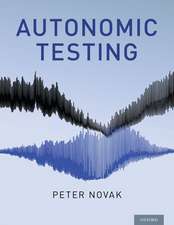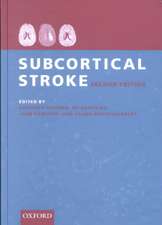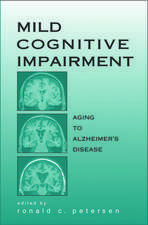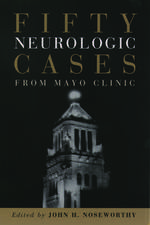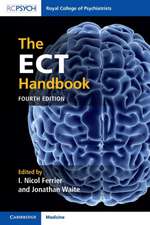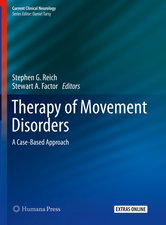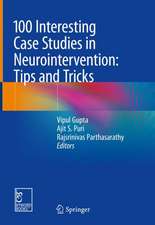Involuntary Movements: Classification and Video Atlas
Autor Hiroshi Shibasaki, Mark Hallett, Kailash P Bhatia, Stephen G. Reich, Bettina Balinten Limba Engleză Hardback – 16 apr 2020
Preț: 586.40 lei
Preț vechi: 807.51 lei
-27% Nou
Puncte Express: 880
Preț estimativ în valută:
112.22€ • 116.73$ • 92.65£
112.22€ • 116.73$ • 92.65£
Carte disponibilă
Livrare economică 13-19 martie
Preluare comenzi: 021 569.72.76
Specificații
ISBN-13: 9780190865047
ISBN-10: 0190865040
Pagini: 208
Dimensiuni: 239 x 160 x 15 mm
Greutate: 0.57 kg
Editura: Oxford University Press
Colecția OUP USA
Locul publicării:New York, United States
ISBN-10: 0190865040
Pagini: 208
Dimensiuni: 239 x 160 x 15 mm
Greutate: 0.57 kg
Editura: Oxford University Press
Colecția OUP USA
Locul publicării:New York, United States
Recenzii
This book is multi-authored and written by experts in the field, which allows it to offer current, evidence-based approaches to classification, pathophysiology, and treatment of each movement disorder. Video illustrations are edited to make them more educational. I can see myself relying on this book during my outpatient practice as a neurologist.
The book should appeal to a very broad audience of subspecialties as well as levels of experience. In an era of remarkable advances in the biological sciences, there is still a vital need for astute and accurate neurological observation, and this is probably more so the case in the field of movement disorders than all others. Involuntary Movements: Classification and Video Atlas addresses this critical need.
Written by internationally recognized experts, this comprehensive volume consists of a detailed description of the various movement disorders accompanied by illustrative and well-edited videos. In addition to all the major hyperkinetic disorders […], the authors also cover functional (psychogenic) and sleep-related movement disorders as well as disorders of increased muscle stiffness or over-activity. The book and video atlas will be especially valuable to residents, fellows and other trainees interested in movement disorders, as well as general neurologists, neurosurgeons, psychiatrists, and physiatrists in academia and in practice.
When spotting a person with uncontrollable, abnormal movements and postures, one's eyes are locked onto the subject, as if mesmerized, trying to interpret what is happening to that person. And so it is with looking at videos of a wide collection of involuntary movements collated in this atlas by and from the combined experiences of the authors. They share their skill and knowledge in helping the reader navigate the complexity of different patterns of involuntary movement following a classification system to lead the clinician to make the correct diagnosis. This Atlas has something to offer for everyone - novices just entering the specialty of movement disorders to the most experienced veteran.
This atlas is excellent, the awaited first encyclopedia of many involuntary movements provided by five world-wide movement disorders specialists based on their own experiences. It definitely helps young neurologists to know how to see involuntary movements and also helps senior neurologists or movement disorders specialists to improve their daily clinical practice.
The book should appeal to a very broad audience of subspecialties as well as levels of experience. In an era of remarkable advances in the biological sciences, there is still a vital need for astute and accurate neurological observation, and this is probably more so the case in the field of movement disorders than all others. Involuntary Movements: Classification and Video Atlas addresses this critical need.
Written by internationally recognized experts, this comprehensive volume consists of a detailed description of the various movement disorders accompanied by illustrative and well-edited videos. In addition to all the major hyperkinetic disorders […], the authors also cover functional (psychogenic) and sleep-related movement disorders as well as disorders of increased muscle stiffness or over-activity. The book and video atlas will be especially valuable to residents, fellows and other trainees interested in movement disorders, as well as general neurologists, neurosurgeons, psychiatrists, and physiatrists in academia and in practice.
When spotting a person with uncontrollable, abnormal movements and postures, one's eyes are locked onto the subject, as if mesmerized, trying to interpret what is happening to that person. And so it is with looking at videos of a wide collection of involuntary movements collated in this atlas by and from the combined experiences of the authors. They share their skill and knowledge in helping the reader navigate the complexity of different patterns of involuntary movement following a classification system to lead the clinician to make the correct diagnosis. This Atlas has something to offer for everyone - novices just entering the specialty of movement disorders to the most experienced veteran.
This atlas is excellent, the awaited first encyclopedia of many involuntary movements provided by five world-wide movement disorders specialists based on their own experiences. It definitely helps young neurologists to know how to see involuntary movements and also helps senior neurologists or movement disorders specialists to improve their daily clinical practice.
Notă biografică
Dr. Hiroshi Shibasaki is an emeritus professor at the Kyoto University Graduate School of Medicine and served as the President of the International Federation of Clinical Neurophysiology from 2007 to 2010.Dr. Mark Hallett is the former President of the American Association of Neuromuscular and Electrodiagnostic Medicine and the International Parkinson and Movement Disorder Society.Dr. Stephen G. Reich is the Frederick Henry Prince Distinguished Professor of Neurology at the University of Maryland School of Medicine.Dr. Kailash Bhatia is a Professor of Clinical Neurology in the Sobell Department of Movement Neuroscience at the Institute of Neurology, University College London.




